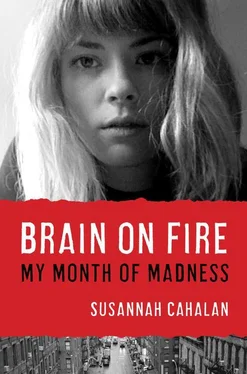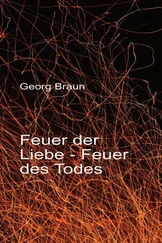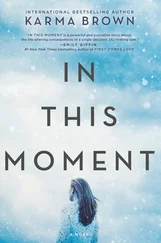Stephen would arrive around 7:00 p.m. and stay until I fell asleep around midnight. The nursing staff okayed this, even though visiting hours had ended long before, because his calming influence meant that I would not try to escape. Every night Stephen and I watched a twenty-four-minute DVD of Ryan Adams at Austin City Limits, which was on a constant loop. He left it running when he went home, the alt-country songs “A Kiss Before I Go,” “A Hard Way to Fall,” and others playing like twangy lullabies over and over again until a night nurse, seeing that I’d fallen asleep, would turn the television off. Stephen thought the music might somehow help bring me back.
Instead, every time I watched this DVD, it was as if for the first time. My short-term memory had been obliterated, a problem usually rooted in the hippocampus, which is like a way station for new memories. The hippocampus briefly “stores” the patterns of neurons that make up a memory before passing them along to the parts of the brain responsible for preserving them long term. Memories are maintained by the areas of the brain responsible for the initial perception: a visual memory is saved by the visual cortex in the occipital lobe, an auditory memory by the auditory cortex of the temporal lobe, and so forth.
To understand how important the hippocampus is to the circuitry of the brain, all you have to do is consider what happens when it is removed, as in the famous case of the patient who became known to the medical world as H.M. In 1933, a bicycle struck seven-year-old Henry Gustav Molaison near his home in Hartford, Connecticut, knocking him out cold. 22After that fateful accident, H.M. experienced clusters of seizures that increased in intensity until, by his twenty-seventh birthday in 1953, his doctor had decided to remove the bit of brain tissue that seemed to be the focus of his seizures: the hippocampus. When H.M. recovered from the surgery, the seizures were gone, but too went his ability to make memories. The doctors noticed that his old memories were intact up to two years before the surgery, but he could no longer retain new ones. Any new information stayed with him for a mere twenty seconds before it vanished. H.M. lived into his eighties, but always thought of himself as a young man in his mid-twenties, the age he was before his surgery.
His uniquely terrifying situation made him one of the most famous medical studies in history, helping researchers to confirm the existence of anterograde amnesia, or the inability to create new memories. (The movie Memento is modeled after H.M.) His case also established the existence of two different types of memory: declarative (places, names, object, facts, and events) and procedural (those learned as a habit, like tying shoes or riding a bike). Although H.M. could not make any new declarative memories, he retained his procedural memory, which he could unconsciously strengthen with practice.
More recently, an orchestra conductor named Clive Wearing contracted a devastating form of herpes simplex encephalitis that ravaged his brain, destroying his hippocampus. Like H.M., Wearing could not retain any new declarative memories, meaning that his world was constantly new to him. He couldn’t recognize his children, and whenever he saw his wife, to whom he had been married for years, he felt as if he was falling in love for the first time. His wife, Deborah, wrote a book about his case, aptly titled Forever Today . In it she wrote: “Clive was under the constant impression that he had just emerged from unconsciousness because he had no evidence in his own mind of ever being awake before.” 23A prolific writer himself, Wearing kept lengthy diaries. But instead of filling them with insight or humor, he was constantly writing the following:
} 8:31 AM: Now I am really, completely awake.{
} 9:06 AM: Now I am perfectly, overwhelmingly awake.{
9:34 AM: Now I am superlatively, actually awake.
Deborah quotes her husband: “I haven’t heard anything, seen anything, touched anything, smelled anything. 24It’s like being dead.”

Although my case luckily was not yet as severe as these, I too had lost key parts of my brain function. Still, certain little things brought me joy: I looked forward to the slow, rickety walks that allowed me to skip the daily shots required to prevent blood clots in bedridden patients. Beyond that, I had two other obsessions, apples and cleanliness. Whenever anybody asked me what I wanted, my answer was always the same: “Apples.” I expressed a constant desire for them, so everyone who visited brought apples: green ones, red ones, tart ones, sweet ones. I devoured them all. I don’t know what prompted this fixation; perhaps some metaphorical urge to “have an apple a day, and keep the doctor away.” Or maybe the urge was more basic: apples contain flavonoids, which are known to have anti-inflammatory and antioxidant effects on the body. Was my body communicating something that my mind—and my doctors—didn’t yet understand?
I also insisted on having my clothes changed and cleaned every day. My mother believed this was a subconscious yearning to rid my body of the sickness, whatever it was. I begged the staff to shower me, even though my hair had to remain matted to my skull because of the constant presence of the EEG wires. Two Jamaican nursing assistants would clean me with warm wet towels, dress me, and coo over me, calling me “my baby.” I relaxed in their care. Watching my contentment during these washing sessions, my father wondered if their accents were transporting me back to my infancy, when Sybil had cared for me like a second mother.
That first Saturday, my parents finally allowed a new visitor, my cousin Hannah. Though she was shocked by what she saw when she arrived, Hannah walked in the room and sat down next to me as if she had done this every day. There in the room with my mom and Stephen, she seemed immediately at home, quiet, unassuming, and supportive.
“Susannah, these are from your birthday. We didn’t get to see you,” she said brightly, handing me a wrapped present. I stared blankly back at her with a frozen smile. Hannah and I had made plans in February to celebrate my belated birthday, but I had canceled because of the “mono” that I believed I had contracted.
“Thank you,” I said. Hannah watched hesitantly as I clawed weakly at the present with half-closed fists. I no longer had the dexterity to even open the wrapping paper. My physical slowness and awkward speech pattern reminded Hannah of a Parkinson’s patient. Gently she took the package from me and opened it.
“It’s Death with Interruptions, ” she said. “You liked All the Names, so my mom and I thought you’d like this one, too.” In college I had read José Saramago’s All the Names and spent many nights talking to Hannah’s mother about it. But now I just glanced helplessly at the author’s name and said, “Never read that.” Hannah agreed sweetly and changed the subject.
“She’s really tired,” my mother apologized. “It’s hard for her to concentrate.”
EEG video, March 30, 6:50 a.m., 6 minutes
The scene opens onto an empty bed. My mother, dressed in a Max Mara suit for work, sits nearby, looking pensively out the window. There are flowers and magazines by the bed. The TV is on, and the show Everybody Loves Raymond plays softly.
I enter from offscreen and crawl onto the bed. I do not have my cap on, and my hair is matted down, revealing a strip of wires that fall down my back like a mane. I pull the sheets up to my neck. My mother rubs my thigh and tucks me into the blanket. I remove the blanket and get up, repeatedly touching the wires on my head.
Читать дальше













